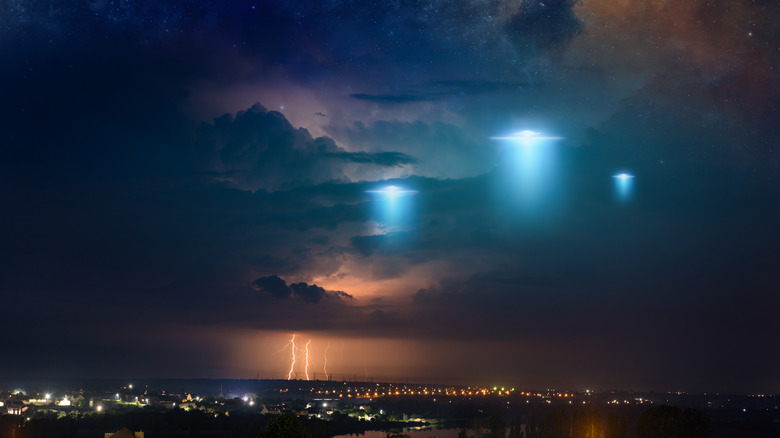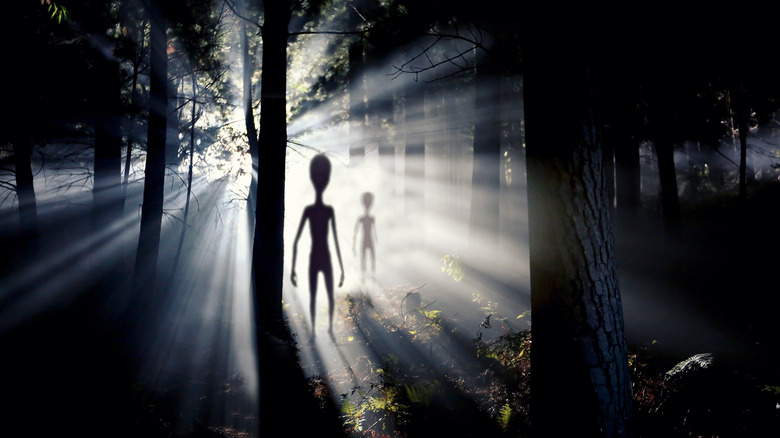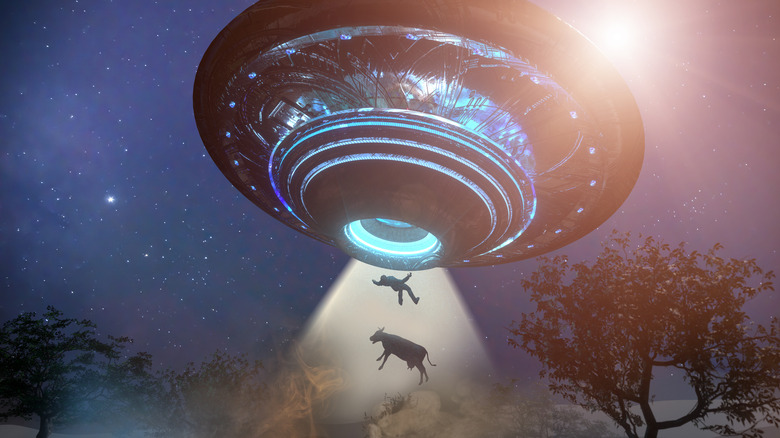What Is The Goal Of NASA's UFO Study Team?
Rejoice, "Ancient Aliens" fans, doomsday cultists, and Roswell gift shop owners! UFOs exist, and now even the government admits it's true. Or at least, the U.S. Defense Intelligence Agency (DIA) admitted it earlier this year through 1,574 pages of actual documents released to The U.S. Sun. All it took was a Freedom of Information Act (FOIA) request, and blamo: we've got access to the DIA's Advanced Aviation Threat Identification Program's (AATIP) honest-to-goodness reports about alien abductions, "energy-related propulsion systems," and medical treatment for exposure to "anomalous" encounters. And now? NASA is creating a 16-person task force to investigate the whole thing. You can practically smell the ray guns already.
To be fair, NASA calls them UAPs — unidentified aerial phenomenon — which admittedly retains far less of a silly ring than "UFOs," a dated term coined in the flyer saucer heyday of the late 1940s, per The Atlantic. But in a move that strips away all the fun, no one involved is admitting that UAPs have anything to do with aliens, as NPR says. The study is an issue of "national security and air safety" — or as Thomas Zurbuchen, associate administrator of the Science Mission Directorate at NASA Headquarters in Washington, D.C., says "Understanding the data we have surrounding unidentified aerial phenomena is critical to helping us draw scientific conclusions about what is happening in our skies. Data is the language of scientists and makes the unexplainable, explainable." Fine, NASA — you keep the data, we'll keep the alien fantasies.
A crack team of analytical experts
So who exactly is on NASA's crack team of 16 alien hunt — er ... ultra-qualified professionals and researchers from a variety of multidisciplinary scientific backgrounds? Daniel Evans, assistant deputy associate administrator for research at NASA's Science Mission Directorate, calls them, "some of the world's leading scientists, data and artificial intelligence practitioners, aerospace safety experts, all with a specific charge," on NASA. They're going to be analyzing data gathered from, "civilian government entities, commercial data, and data from other sources," in conjunction with, "NASA's principles of transparency, openness, and scientific integrity." More than that, they're going to lay the groundwork for future collaborations between NASA and other government organizations regarding UAPs. Pretty important stuff, to say the least.
Judging by the credentials of those involved, NASA's already done a fine job of thinking about the UAP analysis from every possible angle. We've got UAP experts and computer scientists like Anamaria Berea, who works with the SETI (Search for Extraterrestrial Life) Institute in Mountain View, California. We've got a biological oceanographer like Paula Bontempi, a specialist in ecosystems who's worked with NASA on satellite missions. We've got astrophysicists, an astronaut medical care and cancer diagnosis professional, a former astronaut and jet fighter pilot, a journalist with National Geographic, a telescope scientist who help set up the new James Webb Space Telescope, an electrical engineer, aviation safety and threat management people, and more. Sorry, but no Mulder and Scully this time.
The search for alien life and good data
We're 100% sure that there's going to be conspiratorial armchair naysayers calling out NASA for using their analysis to cover some insidious, hidden, blah-blah nonsense about how King Charles III is actually from the Orion constellation or something (side note: you didn't hear this from us). But the truth is that even if the Defense Intelligence Agency is using NASA to smooth over public relations, NASA's research practices are beyond scrupulous. And to be clear, even with the Freedom of Information Act on their side, it still took The U.S. Sun four years to obtain the DIA's reluctantly-given data.
That report came out in April, and by June NASA had stated that they were going to set up a study to investigate, "how to apply the tools of science to shed light on the nature and origin of unidentified aerial phenomena." At the time, it was already decided that David Spergel, chair the astrophysics department at Princeton University, would head the study up. "Given the paucity of observations," he stated, "our first task is simply to gather the most robust set of data that we can."
This isn't the first time NASA has turned its attention to alien-adjacent research. It's used the Transiting Exoplanet Survey Satellite and Hubble Space Telescope, and now the new James Webb Space Telescope, to search for biomarkers – signs of alien life — on exoplanets. NASA says the current study will be released to the public mid-2023.


